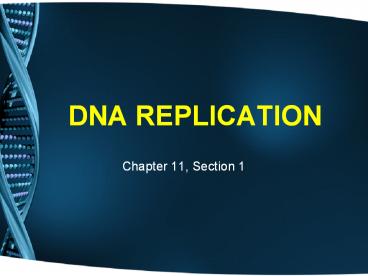DNA REPLICATION PowerPoint PPT Presentation
1 / 15
Title: DNA REPLICATION
1
DNA REPLICATION
- Chapter 11, Section 1
2
Think, Pair, Share
- 1.What is the building block of DNA?
- Nucleotides (Sugar, Phosphate, Base)
- 2. What is the shape of DNA?
- Double Helix
- 3. What 2 bonds hold nucleotides together?
- Hydrogen bonds(bases) Covalent (Sugar Phosphate)
- 4. During what part of the Cell Cycle does DNA
replicate? - Interphase (S-phase)
- 5. What pairs with G? A? Number of Hydrogen
Bonds? - Guanine Cytosine (3), Adenine Thymine (2)
- 6. Which are the Purines? Pyrimidines? Rungs for
each? - Purines AG (2 rungs) Pyrimidines TC (1 rung)
- 7. What are the complimentary bases for the
following sequence? AATCCGC - TTAGGCG
3
(No Transcript)
4
How DNA Replicates
- DNA has to be replicated before a cell divides
- New cells at the end of Mitosis need identical
strands of DNA
5
Think, Pair, Share
- 8. Explain semiconservative replication
- One strand of DNA gets used as a template
(pattern) to make a new strand that matches up
with it - Special enzymes are required for DNA replication
6
Steps of DNA Replication
- 1. Replication begins with the unwinding
separation of the DNA double helix by enzymes
called helicases - The process is like unzipping a zipper
7
- 2. New strands are formed by enzymes called DNA
polymerase which adds complimentary nucleotides
to the original strands - 3. Leading Strand (continuous) vs. Lagging
Strand (discontinuous)
8
Semi-conservativeReplication
- Each new strand compliments one of the original
strands - 2 identical DNA double helix strands are the
result of DNA replication
9
- http//www.wiley.com/college/pratt/0471393878/stud
ent/animations/dna_replication/index.html
10
Uneven formation of DNA
- When DNA is replicating one strand forms
continuously and the other strand forms in chunks
with spaces that need to be filled in
11
DNA 5 to 3
- Anti-parallel
- In the double helix one strand is right-side
up, the other strand is up-side down - If not, the nitrogen bases wouldnt be able to
bond together
12
- 5 and 3 come from how the carbons in the
5-carbon sugar get numbered
13
5 end
3 end
14
- DNA polymerase can only add nucleotides to the 3
end of a strand of DNA - That means that the newly forming strand is
forming from 5 to 3 - That means
- One strand gets to form continuously
- The other strand gets formed in chunks called
Okazaki fragments that need to be connected by
the enzyme DNA Ligase
15
- http//highered.mcgraw-hill.com/olcweb/cgi/pluginp
op.cgi?itswf535535/sites/dl/free/0072437316
/120076/micro04.swfDNA20Replication20Fork - Important Terms- semiconservative replication,
anti-parallel, 5 to 3 - 3 enzymes you must know the function of are
Helicase, DNA Polymerase, and Ligase

